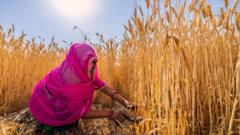As the Indian weather agency reports an unprecedented temperature surge, last month's February recorded the hottest readings in 125 years, signaling early summer heat waves that threaten both the agricultural and textile sectors. Business owners and farmers are scrambling to cope with shifting climate patterns, impacting livelihoods and productivity.
Nitin Goel, who has been part of the textile industry in Ludhiana for five decades, has seen drastic changes in his clothing business as winter gets increasingly shorter. “We've had to switch to t-shirts instead of sweaters,” he lamented, noting a significant drop in sales—down 10% this season and half of what they were five years ago. As the cool weather recedes, manufacturers like Goel find major retail clients hesitant to fulfill even prearranged orders due to soaring temperatures.
The Indian Meteorological Department has predicted that above-average temperatures and heatwaves will persist through the upcoming months. This has driven small business owners to alter their traditional practices, such as adopting a “sale or return” model, thereby transferring the risk of unsold stock back to manufacturers.
Meanwhile, farmers in Devgad are grappling with severe losses in their prized Alphonso mango orchards, an important export product. Vidyadhar Joshi, an orchard owner, revealed that expected production could plummet to just 30% of the normal yield due to excessive heat, forcing him to resort to costly irrigation solutions. Many farmers are even sending their seasonal labor back home due to decreased workloads.
The repercussions extend beyond fruit production, threatening staple crops such as wheat and chickpeas. Experts express skepticism about predictions of a bumper wheat crop, especially following a 15-25% yield reduction noted in the previous year due to intense heat. The situation prompts concerns over food availability, as India may have to depend on costly imports and endure prolonged export bans.
Adding to the urgency, reservoir levels in northern India have declined to only 28% capacity, further stressing agriculture and the dairy sector, which is already facing a 15% drop in milk production in certain regions. These agricultural hardships not only threaten food supplies but could contribute to rising inflation and stymie India's recovery from economic downturns.
Think tanks believe prompt action is essential, including improved weather forecasting, agriculture insurance, and adapting crop calendars based on climate data. This is especially crucial for a nation like India, with about 75% of its districts classified as extreme event hotspots, pointing toward uneven weather patterns leading to both droughts and floods.
As climate change accelerates, the forecast for India indicates a potential loss of nearly 5.8% of daily working hours due to heat stress by 2030. An earlier estimate pegged losses from decreased labor capacity across various sectors at $159 billion in 2021, amounting to 5.4% of its GDP. Without immediate and strategic interventions, India's trajectory could shift towards a future marked by increasing heatwaves, impacting lives and economic stability alike.





















